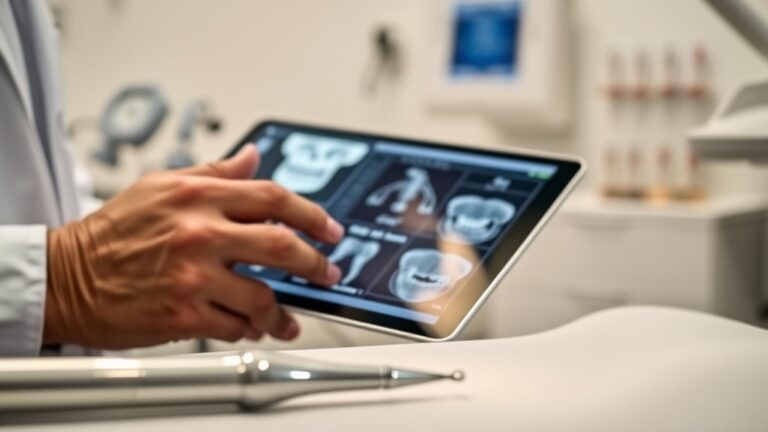Top HIPAA-Compliant Dental Analytics Tools for Practices
Just as a skilled detective pieces together clues to solve a case, you can harness the power of analytics to elevate your dental practice. With the right HIPAA-compliant tools, you won't just analyze data; you'll reveal insights that improve patient care and streamline operations. But what features should you prioritize, and how do these tools guarantee compliance while enhancing your workflow? The answers could change your approach to practice management. If you need assistance navigating these options, feel free to contact us. We can connect you with experts who can provide tailored solutions for your practice.
Key Features of Dental Analytics Tools
Dental analytics tools are revolutionizing how practices manage and utilize data to enhance patient care and operational efficiency. One of the key features you'll find within these tools is robust data visualization. This capability allows you to easily interpret complex data sets, transforming numbers into clear charts and graphs. By visualizing data trends, you can quickly identify areas of strength and weakness in your practice.
Moreover, these tools excel in trend analysis, enabling you to analyze historical data patterns that help predict potential oral health issues and treatment outcomes. By tracking key performance indicators (KPIs), you can refine your operations and clinical practices, ultimately leading to enhanced patient care. Additionally, leveraging real-time insights can significantly enhance your analytics-driven decision-making process.
Real-time insights play a vital role in decision-making, allowing you to act promptly on data outputs. Automated workflows further streamline your administrative tasks, freeing you to focus on patient engagement and personalized care plans.
Importance of HIPAA Compliance
Maintaining HIPAA compliance is essential for any healthcare practice, as it safeguards patient privacy and guarantees the confidentiality of sensitive health information. By adhering to HIPAA regulations, you not only protect your patients but also foster a relationship built on trust and transparency.
Here are some key reasons why compliance is critical:
- Protects patient data from unauthorized access and potential breaches.
- Empowers patients with control over their health information, enhancing their sense of ownership.
- Reduces the risk of significant financial penalties associated with non-compliance.
- Facilitates secure sharing of information, leading to accurate diagnoses and effective treatment.
- Promotes operational efficiency by streamlining processes and reducing administrative burdens. Additionally, compliance ensures that healthcare practices implement technical, physical, and administrative safeguards to protect electronic PHI.
When you prioritize HIPAA compliance, you guarantee that your practice is equipped to handle sensitive information responsibly. This not only mitigates the risk of legal and financial repercussions but also strengthens patient trust, which is essential in healthcare.
Top Dental Analytics Software
Leveraging advanced dental analytics software can greatly enhance practice management by providing valuable insights into operational performance and patient care. As you explore the latest dental software trends, you'll discover tools like Jarvis Analytics, which transforms your practice management system data into actionable insights. With over 50 specific KPIs tailored for office, doctor, hygiene, and specialty metrics, you can easily monitor clinical excellence and business growth.
Adit Practice Analytics automates data analysis, streamlining administrative tasks while offering real-time insights and a centralized EHR database. This boosts efficiency, reduces errors, and improves treatment planning accuracy through predictive analytics. Furthermore, the analysis of patient data identifies trends contributing to successful treatment results, leading to better outcomes.
Denticon stands out with its thorough solutions, merging business and clinical functionalities, including patient communication and claims management. The cloud-based platform guarantees HIPAA compliance and offers training and 24/7 support for practices of all sizes.
Lastly, Curve Dental provides a user-friendly, web-based solution that accommodates any operating system. With features for scheduling, billing, and imaging, along with ongoing training support, it aligns perfectly with the practice management evolution you're aiming for.
Embrace these tools to enhance the quality of care you provide.
Data Security Measures
As you navigate the complex landscape of dental practice management, implementing robust data security measures is crucial to safeguard patient information and assure compliance with HIPAA regulations. Continuous monitoring of compliance is essential for organizations to maintain HIPAA adherence.
Focusing on effective security protocols not only protects your patients but also enhances your practice's credibility.
Here are key measures to reflect on:
- Point computer screens away from public view to prevent accidental exposure of sensitive data.
- Lock computer rooms and limit physical access to areas where patient information is stored.
- Use strong passwords and multi-factor authentication to secure data access.
- Conduct regular risk assessments with a designated HIPAA security officer to identify vulnerabilities.
- Make certain that patient data is shared only with authorized personnel, with proper consent obtained.
Automating Dental Practice Operations
How can automating dental practice operations transform your workflow and enhance patient satisfaction? By integrating automated systems into your practice, you can greatly improve both patient workflow and administrative efficiency.
For instance, automating appointment scheduling and reminders reduces phone traffic, allowing your staff to focus more on patient care rather than administrative tasks.
Digitizing patient intake forms enables patients to complete paperwork electronically, minimizing wait times and enhancing their overall experience. Additionally, utilizing patient-centric automation can ensure that your practice is always adapting to meet the evolving needs of your patients.
Automated communication, such as reminder texts and follow-ups, keeps patients engaged and informed, ultimately boosting satisfaction and retention rates.
Moreover, automating insurance verification and claims processing reduces errors and streamlines your financial operations, ensuring timely payments.
Incorporating self-service kiosks and virtual check-ins enhances convenience, allowing patients to arrive and check-in with ease.
Analyzing Patient Data Effectively
Automating dental practice operations not only streamlines workflows but also opens up new avenues for analyzing patient data effectively.
By leveraging HIPAA-compliant software, you can harness the power of data visualization and patient segmentation to enhance your practice's insights.
Consider these key aspects for effective data analysis:
- Centralized Data Management: Keep all patient records in a secure, easily accessible location. This is crucial for ensuring HIPAA compliance and protecting patient information.
- Customizable Reporting: Generate tailored reports that provide insights into demographics, treatment histories, and billing.
- Automated Security Protocols: Implement features like auto-logout and real-time monitoring to protect sensitive information.
- Role-Based Access Controls: Limit data access to authorized personnel, minimizing the risk of human error.
- Data Visualization Tools: Use graphical representations to identify trends and patterns in patient behavior and treatment outcomes.
Enhancing Clinical Outcomes
Enhancing clinical outcomes in your dental practice hinges on the effective use of analytics to inform decision-making and treatment strategies. By leveraging predictive modeling, you can analyze patient data to make accurate diagnoses and develop proactive treatment plans tailored to individual needs.
Integrating analytics with radiological assessments guarantees a thorough view of patient records, enabling you to track treatment outcomes and adjust plans as necessary. Additionally, implementing data analytics allows for the identification of patterns that can improve patient care and operational efficiency.
Optimizing clinical workflows is another key area where analytics can make a significant impact. Automating administrative tasks not only reduces your workload but also enhances patient engagement by streamlining front-office activities.
Identifying peak appointment times through data analysis allows for better staffing and improved patient interactions. Moreover, embracing preventive dentistry is essential for enhancing clinical outcomes. By identifying high-risk patients and using predictive analytics to schedule preventive treatments, you can create personalized care plans that promote adherence and improve retention.
Finally, managing dental equipment and resources effectively guarantees compliance and reduces waste, contributing to overall operational efficiency.
Frequently Asked Questions
How Do Dental Analytics Tools Improve Patient Engagement?
Dental analytics tools enhance patient engagement by leveraging patient feedback to refine engagement strategies. You can tailor communication, improve education, and optimize appointment management, ultimately fostering stronger relationships and increasing patient satisfaction within your practice.
What Are the Costs Associated With Implementing Dental Analytics Software?
Implementing dental analytics software can feel like climbing Everest due to initial investment, ongoing maintenance, and software training costs. Prioritizing data security is essential to guarantee a smooth shift and protect patient information effectively.
Can I Integrate Analytics Tools With Existing Practice Management Software?
Yes, you can integrate analytics tools with existing practice management software, ensuring software compatibility. Focus on data security to protect patient information while enhancing your practice's performance through effective, real-time data analysis.
How Often Should I Update My Dental Analytics Tools?
You should update your dental analytics tools regularly to guarantee data accuracy and tool scalability. Frequent updates help maintain real-time insights, optimize practice performance, and enhance patient care through informed decision-making and efficient operations.
What Metrics Should I Focus on for Practice Growth?
To nurture your practice like a flourishing garden, focus on patient retention and revenue growth metrics. Monitor new patient acquisition rates, treatment acceptance, and follow-up appointments to cultivate loyalty and financial health effectively.
Conclusion
In summary, utilizing HIPAA-compliant dental analytics tools like Jarvis Analytics can greatly transform your practice. For instance, a dental practice that adopted Adit Practice Analytics saw a 30% increase in patient retention by leveraging real-time data insights to tailor their services. By prioritizing data security and automating operations, you not only enhance patient care but also foster trust and engagement within your community.
If you're looking to navigate these advancements but feel overwhelmed, don't hesitate to reach out to us for assistance. Getting expert help can save you time, reduce stress, and significantly improve your dental practice. Embracing these technologies is essential for steering through the evolving landscape of dental healthcare, and we're here to support you every step of the way.





